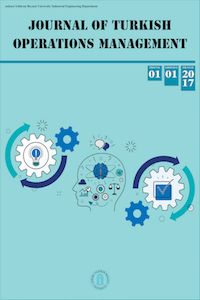MODEL BASED ENGINEERING, OPTIMIZING THE HIGHER EDUCATION GOALS OF TURKEY’S 2050 USİNG (2N+1) GEOMETRIC RATIO MODEL
In this study, (2n+1) geometric ratio model has been developed based on Model Base Engineering (MBM). In this model, the application is made to Turkey's 2050, which consists three parts. The first part is the determination of the problems, the second part is the modeling and the third part offers the solution for the problems. For countries' future, a new structure in higher education is proposed that aims to analyze the whole of higher education system. By using of this planning model, the success will be reached up to 80% in 35 years. If the change in population is taken into consideration, 100% target is reached between 45-50 years. According to the current model in Turkey, the 30% of the total population are graduated from university while the rest of the total population (i.e., 70%) are gradutaed from high school system. The number of universities with the need for Turkey's 2050 targets, qualifications, number of faculty members, suggestions were made in cultivating the missing faculty member. For sustainable development and the development of Turkey it is divided into 10 regions. Turkey's depending on their own resources to compete in the world: 1. Electronic-security,2. Communication, 3. Defense, 4. Health-medicine-drug, 5. Food-agriculture-forest and livestock, 6. Software, 7. Energy, for the establishment of scientific research centers, the establishment of 14 technology research transformation technology institutes that will turn local agricultural products and natural resources into industrial products, and the establishment of 7 technology development centers. It is also recommended that all of these centers should work with universities in the region. The basic philosophy of this study is:1. Critical scale economy,2. Critical scale population size,3. Well-educated population ratio,4. Critical technology production in scale size,based on the study. Therefore It represents the size of countries and states.
Anahtar Kelimeler:
Geometrik Oran, Model Taban Mühendisliği, Üniversite, Yüksek Öğretim
0000-0002-0396-9461
In this study, (2n+1) geometric ratio model has been developed based on Model Base Engineering (MBM). In this model, the application is made to Turkey's 2050, which consists three parts. The first part is the determination of the problems, the second part is the modeling and the third part offers the solution for the problems. For countries' future, a new structure in higher education is proposed that aims to analyze the whole of higher education system. By using of this planning model, the success will be reached up to 80% in 35 years. If the change in population is taken into consideration, 100% target is reached between 45-50 years. According to the current model in Turkey, the 30% of the total population are graduated from university while the rest of the total population (i.e., 70%) are gradutaed from high school system. The number of universities with the need for Turkey's 2050 targets, qualifications, number of faculty members, suggestions were made in cultivating the missing faculty member. For sustainable development and the development of Turkey it is divided into 10 regions. Turkey's depending on their own resources to compete in the world: 1. Electronic-security,2. Communication, 3. Defense, 4. Health-medicine-drug, 5. Food-agriculture-forest and livestock, 6. Software, 7. Energy, for the establishment of scientific research centers, the establishment of 14 technology research transformation technology institutes that will turn local agricultural products and natural resources into industrial products, and the establishment of 7 technology development centers. It is also recommended that all of these centers should work with universities in the region. The basic philosophy of this study is:1. Critical scale economy,2. Critical scale population size,3. Well-educated population ratio,4. Critical technology production in scale size,based on the study. Therefore It represents the size of countries and states.
___
- KAYNAKLAR
- 1. Patrice Micouin “Model-Based Systems Engineering Fundamentals and Methods” , First published 2014 in Great Britain and the United States by ISTE Ltd and John Wiley & Sons, In. 2. Ramazan Kılıç, Türkiye’de Yüksek Öğretimin Kapsamı ve Tarihsel Gelişimi, Dumlupınar Üniversitesi, Sosyal Bilimler Dergisi Sayı :3 Kasım 1999. 3. Günay, D. Ve Günay, A. (2017). “Türkiye’de Yüksek Öğretimin Tarihsel Gelişlimi Ve Mevcut Durumu”, Yüksek Öğretim Dergisi, 7(3), 156–178. Doi:10.2399/Yod.17.024. 4. Günay, D. ve Günay, A. (2011). 1933’den günümüze Türk yüksek öğretiminde niceliksel gelişmeler. Yüksek öğretim ve Bilim Dergisi, 1(1), 1–22. 5. TUİK,www.tuik:gov.tr-20196. https://istatistik.yok.gov.tr-20197. BM Nüfus Tahmin Raporu, https://www.haberler.com/bm-nin-2050-dunya-nufusu-tahmini-9-8-milyar-9756091-haberi/ 2019. 8. Kaynak:wikiwand.com-20199. Kaynak: wikipedia.com, 2018.10. Ranking and Records, www.aneki.com-2018. 11. MEB Verileri: İmam Hatip Öğrencilerinin Sayısı Milyonu Aştı - Evrensel.Net, 19 Ocak 2019 e-Gazete, 19.01.2019. 12. “Öğrenci sayısı 17 milyon 319 bin 433 oldu” ,http://www.milliyet.com.tr/ogrenci-sayisi-17-milyon-319-bin-gundem-2424136/ 31.03.2017 18:13, Son Güncelleme:31.03.2017-18:18 13 2016-2017 Milli Eğitim Istatistikleri Yayınlandı, Sözcü Gazetesi,17 Nisan 2017,10.01.2019 19'10 .14. MEB, Son Bir Yılda Açık Öğretimde Yüzde 22,66 Artış Dayandığına Dikkati Çekti. Açık Liselerde Öğrenci Sayısı Patladı, Kazete: Özgür Kadının Sesi, Cumartesi, 19 Ocak 2019, 18:55:48. 15. “MEB, Öğretmen Ve Öğrenci Sayısı İstatistiklerini Paylaştı”, “www.mebpersonel. com” / meb-personeli/meb-öğretmen-ve-öğrenci-sayisi-istatistiklerini-paylasti-h224851.html 16. http://www.pervinkaplan.com/detay/yarim-milyon-öğrenci-imam-hatip-lisesinde-okuyor/5893. 17. Yüksek öğretime bakış 2018: İzleme ve değerlendirme raporu. Ankara: Eğitim-Bir-Sen Stratejik Araştırmalar Merkezi . 2018.18. Remzi Yıldırım, “Optimization And The Geometric Ratio Model And Its Application To Higher Education In The Future”, American Journal of Engineering Research (AJER) e-ISSN: 2320-0847, p-ISSN : 2320-0936 Volume-7, Issue-6, pp-209-214, 201819. Mete Gündoğan, Remzi Yıldırım, “Restructuring Governments Using A Geometric Ratio Technique And Its Multiple Effects” Journal of Turkish Operations Management, JTOM, 2018-2. 20. Remzi Yıldlrlm, Samettin Gündüz, “Countries’ Future Higher Education Structure And Optimizing”, American Journal of Engineering Research (AJER) e-ISSN: 2320-0847 p-ISSN : 2320-0936 Volume-7, Issue-10, pp-118-138, 2018.
- ISSN: 2630-6433
- Başlangıç: 2017
- Yayıncı: Ankara Yıldırım Beyazıt Üniversitesi
